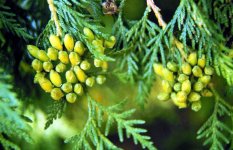Thuya western
Thuja occidentales L.
Botanical characteristics.
Refers to the family cypress. Evergreen low tree with branches raised. The leaves are dense, dark green, arranged in 4 rows. Flowers unisexual, scaly, plant monocotyledonous. Fruits are obovate cones in which brown, wide-winged seeds are located.
Leaves of thuja can cause skin burns.
Spread. Originally from North America. As an ornamental and medicinal plant has long been cultivated in the southern regions of our country. In recent years, thuyu successfully bred in the middle zone of Russia.
Used parts of the plant.
Shoots of thuya.
The chemical composition of thuya has been little studied. It contains tuyac acid, essential oil and tannins.
Application.
In scientific medicine is not applied. It is used in diseases of the liver and kidneys, allergic reactions, metabolic diseases. Assign with metabolic arthritis, with osteochondrosis, hepatocholecystitis, cholelithiasis, cystitis, urethritis, chronic prostatitis and prostate adenoma. Thuja is indicated for edema (it acts diuretic), as well as for round worms as a vomiting agent.
In folk medicine, thuja has long been used as a resorptive for neoplasms, with scarring and soldering. Locally, as a tincture, tuyu is used in the treatment of lupus erythematosus.
Contraindications. Pregnancy. The plant is weakly toxic, taken under medical supervision.
Preparation.
Infusion: 1 tablespoon of herb infused with 200 ml of boiling water - daily dose. Drink in 3 divided doses 30 minutes before meals.
Alcohol tincture is prepared at a rate of 1:10. Take inside 10-15 drops 3-4 times a day, and also use as an external means.
It is used in homeopathy Thuja 3x, 3, 6 with diseases of the urinary tract, tumor growth of the skin, allergic reactions, headaches and dimenorrhea.
The pathogenesis of thuya is described by Hahnemann himself in "Pure Medicine" and in subsequent years was supplemented by numerous researchers.
Special features: skin lesions, especially in the genital area and anus, cystalgia with burning and soreness with urination;
Headaches with a feeling, as if the nail is stuck in the head, the expressed left-sidedness of the symptoms, etc.




Comments
When commenting on, remember that the content and tone of your message can hurt the feelings of real people, show respect and tolerance to your interlocutors even if you do not share their opinion, your behavior in the conditions of freedom of expression and anonymity provided by the Internet, changes Not only virtual, but also the real world. All comments are hidden from the index, spam is controlled.